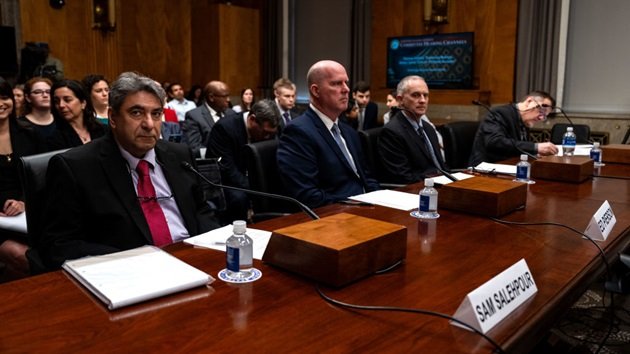WMEX Boston
Listeners:
Top listeners:
-
 play_arrow
play_arrow
WMEX WMEX Boston
-
 play_arrow
play_arrow
Courage To Hope-Episode 82-Michael Courage To Hope-Episode 82-Michael
Boeing safety culture under scrutiny during Senate committee hearing
todayApril 17, 2024

Kent Nishimura/Getty Images
(WASHINGTON) — Boeing’s safety culture came under scrutiny during a U.S. Senate hearing on Wednesday, where a Boeing whistleblower was among those who testified about the company’s production methods in the wake of the Alaska Airlines door plug blowout.
Boeing engineer Sam Salehpour, who first spoke out earlier this month on the company’s production of the 787 and 777 jets, was among four witnesses who testified in front of the Senate Committee on Homeland Security & Governmental Affairs’ Permanent Subcommittee on Investigations.
“I have analyzed Boeing’s own data to conclude that the company is taking manufacturing shortcuts on the 787 program that may significantly reduce the airplane safety and the lifecycle,” Salehpour testified.
Salehpour claimed that since 2013, there have been serious issues in the 787 program, describing those issues as “gaps in its assembly of the fuselage” of the 787. Salehpour said Boeing pushed pieces of the fuselage together with “excessive force” to make it seem like the gaps in the fuselage didn’t exist. Salehpour said that 98.7% of the time, the gaps that were supposed to have shims did not have shims.
“I literally saw people jumping on the pieces of the airplane to get them to align,” said Salehpour about the 777 production line. “I call it the Tarzan effect.”
Salehpour claimed he was sidelined and told to “shut up” and that his boss told him that he would have “killed someone” who said what Salehpour said.
The Federal Aviation Administration is investigating Salehpour’s claims regarding the 787 and 777 production.
Boeing has refuted Salehpour’s claims regarding the structural flaws of the jets and said it is “fully confident” in the safety of both.
“In 13 years of service, the global 787 fleet has safely transported more than 850 million passengers on more than 4.2 million flights,” Boeing said in a statement Wednesday prior to the hearing. “A 787 can safely operate for at least 30 years before needing expanded airframe maintenance routines. Extensive and rigorous testing of the fuselage and heavy maintenance checks of nearly 700 in-service airplanes to date have found zero evidence of airframe fatigue. Under FAA oversight, we have painstakingly inspected and reworked airplanes and improved production quality to meet exacting standards that are measured in the one hundredths of an inch.”
The 777 fleet has “safely flown more than 3.9 billion passengers around the world” and “remains the most successful widebody airplane family in aviation history,” Boeing added.
Following the hearing, the company said “retaliation is strictly prohibited at Boeing.”
Boeing has come under intense scrutiny after a door plug blew out of an Alaska Airlines flight on Jan. 5. Investigators with the National Transportation Safety Board found that the plane, a 737 Max, was missing four bolts when the door was installed.
Boeing has not turned over records documenting the work on the door plug, NTSB Chair Jennifer Homendy told the Senate Commerce Committee last month, saying that Boeing informed them that they are unable to find the records.
Ed Pierson, executive director of the Foundation for Aviation Safety and a former Boeing manager, testified during Wednesday’s Senate hearing that a whistleblower provided him with the records, and that he then turned them over to the FBI.
“I’m not going to sugarcoat this. This is a criminal cover-up,” Pierson said. “Records do, in fact, exist. I know this because I personally passed them to the FBI.”
Pierson said the records have been available “for months.” He has not publicly produced the documents.
An FBI Seattle spokesperson declined to comment to ABC News on Pierson’s claim that he turned Boeing records over to the FBI.
Boeing referred ABC News to Homendy’s comments at the Senate hearing on April 10, in which she characterized the lack of records as an “escape from normal process” and said that Boeing has provided the NTSB with “all the documents that we’ve asked for that exist, they are aware that this record does not exist. They are equally concerned about the process here and the escape. And we are all working together to figure out what happened to rectify the situation and anything else going forward.”
In response to Pierson’s testimony, the NTSB said in a statement that during the hearing on April 10, Homendy “reiterated that Boeing indicated to the NTSB that it did not have documentation detailing the work on the opening, closing, and securing of the door plug that blew out during a January 5 passenger flight operated as Alaska Airlines flight 1282.”
“The NTSB has not received any such documentation from Boeing or any other entity,” the statement continued.
Pierson, who has not worked at Boeing in six years, also testified Wednesday on the safety culture at Boeing, telling senators, “The manufacturing conditions that led to the two 737 Max disasters also led to the Alaskan blowout accident, and these conditions continue.”
The crashes of two Boeing 737 Max jets — Lion Air Flight 610 in 2018, and Ethiopian Airlines Flight 302 in 2019 — killed 346 people. Investigators found that both crashes involved a flawed flight control system. The Max was grounded for 20 months before being cleared to fly again in December 2020.
“The world is shocked to learn about Boeing’s current production quality issues. I’m not surprised because nothing changed after the two crashes,” Pierson said. “Government authorities ignored Boeing’s manufacturing problems until the Alaska accident. Passengers shouldn’t have to rely on whistleblowers to provide the truth.”
Joe Jacobsen, an aerospace engineer and technical adviser to the Foundation for Aviation Safety and former FAA engineer, testified that since the 737 Max went back into service in 2020, “we have a long list of unsafe conditions for manufacturing defects. We also have a long list, equally long list of design defects. So what that tells me is it’s a company-wide problem.”
Shawn Pruchnicki, professional practice assistant professor of integrated systems engineering at Ohio State University, said that Boeing’s issues, including the two Max crashes, were “100% about money.”
“It leads me to wonder, have we even gone backwards at Boeing? The Alaska Airlines event strongly supports that,” he said.
Sen. Richard Blumenthal, D-Conn., the chairman of the Permanent Subcommittee on Investigations, called the testimony “shocking.”
“There are mounting serious allegations that Boeing has a broken safety culture and a set of practices that are unacceptable,” he said.
Blumenthal said at the conclusion of the hearing that the record will remain open for 15 days for any questions or documents to be submitted.
“We hope that there will be others who will come forward,” he said.
The senator also said they hope to be in touch with the Department of Justice “to indicate our interest in cooperating with them,” as the agency also investigates Boeing.
The hearing lasted just over 90 minutes, as senators said they had a hard out for impeachment proceedings against Homeland Security Secretary Alejandro Mayorkas.
Following the hearing, Boeing said that since 2020, it has “taken important steps to foster a safety culture that empowers and encourages all employees to raise their voice.”
“We know we have more work to do and we are taking action across our company,” Boeing said. “Since January 2024, there has been a more than 500% increase in employee reports through our ‘Speak Up’ portal compared to 2023, which signals progress toward a robust reporting culture that is not fearful of retaliation.”
“We continue to put safety and quality above all else and share information transparently with our regulator, customers and other stakeholders,” the statement said.
The hearing comes two days after Boeing held a press tour of its factory in North Charleston, South Carolina, during which it laid out its engineering process following allegations from Salehpour.
The company said it ran extensive fatigue testing on the 787 Dreamliner, running the test to 165,000 flight cycles and saying it was “the longest fatigue test of any commercial airplane that’s ever been run.” Boeing said the testing took five years to complete and at the end of the testing, there were no findings of fatigue in the 787’s composite structure.
Lisa Fahl, the vice president of engineering for airplane programs at Boeing Commercial Airplanes, also told reporters they encourage employees to speak out.
“We’re on a continuous improvement journey on ensuring that our teammates’ opinions and questions get answered,” Fahl said. “We hear from them, we create processes, we continue to evolve on this process as we go forward and just welcome the feedback and encourage it and want it from our team, that’s how we make us better, that’s the foundation of the Safety Management System and aerospace safety in general, is people speaking up.”
Copyright © 2024, ABC Audio. All rights reserved.
Similar posts
CONTACTS
- https://wmexboston.com
- 781-834-WMEX(9639)
- studio@wmexboston.com
- 130 Enterprise Dr, Marshfield, MA 02171
ABOUT
WMEX Boston can be heard at 1510 AM, and 101.1 FM. Playing the greatest hits from 50s, 60s, 70s, 80s, and more!
MENU
SPONSORS
Copyright 2024 WMEX Boston - Design by Pro Radio Solutions





